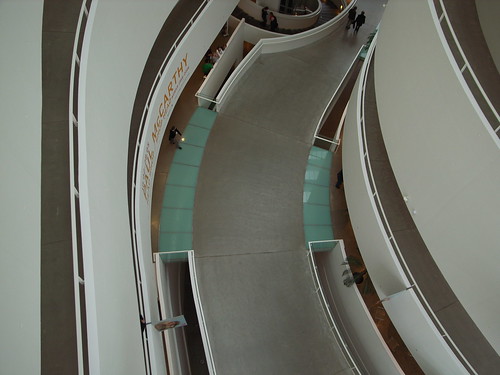Yesterday, I attended Geoware 2007, some of my notes (not on every talks but quick highlights of the day).

Ed Parsons gave a good overview of what is meant by "Geoware", using the term "neogeography": when geography meets web2.0 and rocket science tech becomes everyday. To him, the most important changes in the last couple of years is the fact that big organizations (Yahoo, Google...) licensed information and made them available for free to the users (through a specific business model). Ed's point is that "location" could serve as a contextual filter for information stored in databases. A cardinal rule of geographer is "Everything happens somewhere": that shows the importance of geography. To Ed, the best services won't be about allowing a person to ask where he/she is but rather to offer a service based on where the person is: location is not an add-on, it's too difficult to query a map on a cell phone when biking in a city, there is a need to have another model: location should be implicit, less explicit. Porn adopted it already: see the website that propose you people in the vicinity! He also cited an example of a cell phone he'd like to have that would offer him choices depending on the context: for instance if he is stuck in a traffic jam on his way to the airport, he'd like to have a 2 options choice like "delay plane" and "call XX".
Lukas-Christian Fischer (Plazes) also offered few hints about their strategy. For them, presence is a powerful factor, an answer to establish a contact (prior to communication). It comes down to who did what where, who has done what where and who will be doing stuff where. The 3 functions of Plazes he described are (1) coordination (meeting up with real people), (2) collection (identity from where you've been), (3) exploration (finding new corners of the world). Plazes takes location as a social object, this statement has been interestingly thrown out by Sean Treadway and it quite reminds me of Jyri Engestrom's work (and after a quick chat with them, they referred to jyri...). Besides, they decribed how Plazes is the largest database of hot-spots. What I find good about Plazes (and also about Jaiku) is that the user is in control and that the system convey intentionality (that's the sort of things I discuss in my talk).
Jeremy Irish presented elements about geocaching ("mark a location and go find it"). From this simple point, things evolve to more complex situations such as: waymarking that allows to attach data to a point, build communities around unique and useful locations in the world, encourages participants to use GPS units to mark locations and take photos, locations are searchable by category. But, as he said, people want to make puzzle caches more interactive: WHEREiGO: free tools for creating media-rich GPS experiences, instead of marking a point, you create a zone in a region: real-world adventure game, tour guides. His point is to turn a point into an experience. His conclusion: "it's time to go outside and play".
Another great talk has been given by Carlo Ratti (MIT Senseable city). Carlo presented different projects they carry out at his lab (RealTime Rome, Mobile Landscape Graz, iSPOTs, iFIND and Wikicity). His lab's mission is rethinking in a creative way the interface between people, mobile technology and the city. He nicely referred to situationism (homo ludens!) by saying that what they keep from this area is the notion of "environment as flows and less built space". The project he mentioned are mostly based on how to represent cities using various traces (such as mobile phone calls). In the last one (wikicity), the point if get these data back to citizens (a sort of "feedback control system"), One of the project that is of interest to me is the AC Milan traces analysis:

"Information about the movement of soccer players on the field during a match can be useful for strategic and physiologic analysis, directed at improving the performance of the players and that of the team. The use of electronic sensing techniques – mostly computer vision – for automatically tracking the players has been an area of active research for many years. An optimum solution, however, has yet to be found. The problem is challenging from a technical point of view because the sensing area is large compared to the moving actors (players), the actors move fast and occlusion and congestion occur frequently."
Less related to my work and the stuff I like, there was a talk by Morten Kromann Larsen (TNS-Gallup) in which he explained how billboard companies (JCDecaux and Clearchannel) assess the exposure of people to commercial in the streets. The talk was a comparison between "GIS versus GPS": 1) GIS: people are contacted and interviewed by the phone and they have (at the same time) to go online to draw their daily path in the city on a map. It's basically a recollection based on people's memory. 2) GPS: people are given a GPS device they put in heir pocket while wandering around in the city (they only take 50 persons because the cost is higher). There is hence an automatic collection of the movement in space. Morten then showed slides depicting the results: when comparing the 2 methods, they found the same pattern of behavior: there is a 82% overlap. So they recommend the GIS method as a favored approach, since it's easier and less demanding from respondents. I am less interested by the purpose of the trials, but rather by what they guy was saying: how people are good to remember their path is space (especially when you have a person on the phone helping them with cues, landmarks, reminding them their activities...).
A quite good event and a superb organization. Good chat with lots of people!
